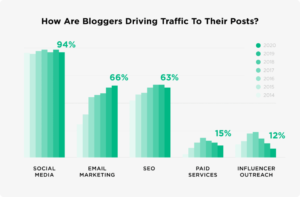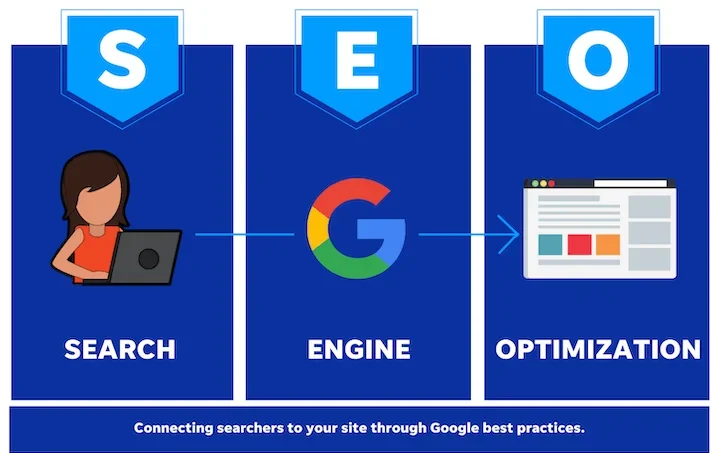Table of Contents
ToggleWhat Is Blog SEO?
Blog SEO is the practice of optimizing a blog’s content, site architecture and HTML code for search engines. Common tasks associated with blog SEO include on-page optimization, installing plugins, improving page loading speed and internal linking.
Why Is Blog SEO Important?
Search engines are a super important traffic source for blogs.
In fact, a recent survey of over 1000 bloggers found that SEO was their 3rd most important source of traffic

Our own blog is living proof of the power of SEO. Sure, we get a fair amount of traffic from Twitter, LinkedIn, email and direct traffic. And added together, these sources make up the majority of our monthly traffic.
But Google sends us over 396,000 visitors per month.
Without blog SEO, our site’s growth would have been much slower.
And if you want to learn how to optimize your blog for SEO, check out these tested SEO tips.
Best Practices
Find One Main Keyword For Each Post
Every blog post that you publish should be optimized around one keyword.
If you optimize your post around lots of different keywords, Google and other search engines get confused. They don’t know what your content is actually about.
But when you focus on a single keyword, Google can easily understand that your post is about that one topic.
So your first step is to find one main keyword for your post.
If your blog is new, I recommend focusing on long tail keywords at first. That’s because long tail terms aren’t super competitive.
Optimize Your Blog Post
Now that you’ve found a long tail keyword, you want to optimize your post around that term.
There’s no need to stuff your keyword a million times on your page. That’s called “keyword stuffing”. Keyword stuffing used to work back in the day. But it can do more harm and good today.
Instead, you want to include your keyword in a few key places on your page.
Title and Title Tag
Most CMSs (like WordPress) have a title field at the top of the post.
Search Engine Optimization (SEO) is the practice of optimizing a website or online content to improve its visibility and ranking on search engine results pages (SERPs). The goal of SEO is to increase organic (non-paid) traffic from search engines like Google, Bing, and Yahoo by ensuring that the website appears higher in search results for relevant keywords and phrases.
Key Components of SEO
SEO is generally divided into two main categories: On-Page SEO and Off-Page SEO. There’s also a technical aspect to SEO, which focuses on the backend of the website.
On-Page SEO: This involves optimizing individual web pages to rank higher and earn more relevant traffic in search engines. Key elements include:
- Keywords: Researching and using relevant keywords that potential customers might use when searching for products or services. This includes placing keywords in strategic places like the title tag, meta description, headers, and throughout the content.
- Content Quality: Creating high-quality, valuable, and relevant content that meets the needs of users. Content should be well-structured, informative, and engaging.
- Meta Tags: Optimizing meta tags such as the title tag and meta description to accurately describe the content and include targeted keywords.
- URL Structure: Creating clean, descriptive, and keyword-rich URLs that make it easier for search engines and users to understand the page content.
- Internal Linking: Linking to other relevant pages on your website to help search engines understand the structure and importance of different pages.
Off-Page SEO: This focuses on activities outside of your website that impact your rankings within search engine results pages. Key elements include:
- Backlinks: Acquiring high-quality backlinks from reputable websites. Backlinks act as votes of confidence, signaling to search engines that your content is valuable and authoritative.
- Social Signals: While not a direct ranking factor, social signals (such as shares, likes, and comments on social media platforms) can contribute to your SEO by driving traffic to your site and increasing its visibility.
- Brand Mentions: Being mentioned on reputable sites or blogs without necessarily having a direct link to your website can also help with SEO. Search engines recognize brand mentions as a sign of credibility.
Technical SEO: This involves optimizing the technical aspects of a website to ensure that search engines can crawl and index it effectively. Key elements include:
- Website Speed: Ensuring your website loads quickly is crucial for both user experience and search engine rankings. Slow-loading pages can lead to higher bounce rates and lower rankings.
- Mobile-Friendliness: With the increasing use of mobile devices, it’s essential that your website is mobile-friendly and responsive, providing a good user experience on all devices.
- Secure Sockets Layer (SSL): Having an SSL certificate (indicated by “https” in the URL) ensures that your website is secure, which is a ranking factor for search engines.
- XML Sitemap: Creating and submitting an XML sitemap helps search engines understand the structure of your website and index all your pages effectively.
- Robots.txt: A file that tells search engines which pages or sections of your site they should or shouldn’t crawl.
Benefits of SEO
- Increased Visibility: Higher rankings in search engine results pages lead to increased visibility, making it easier for potential customers to find your website.
- Higher Quality Traffic: SEO helps attract more relevant traffic, as users searching for specific keywords are more likely to be interested in your products or services.
- Cost-Effectiveness: Unlike paid advertising, organic traffic generated from SEO doesn’t require ongoing payments. It can provide a high return on investment (ROI) over time.
- Credibility and Trust: Websites that rank higher are often perceived as more credible and trustworthy by users. SEO can help build your brand’s reputation.
- Better User Experience: Many SEO practices, such as improving site speed and mobile-friendliness, also enhance the overall user experience, leading to higher engagement and conversions.
SEO Best Practices
- Conduct Keyword Research: Identify relevant keywords and phrases that your target audience is searching for. Use tools like Google Keyword Planner, SEMrush, or Ahrefs to find valuable keywords with good search volume and low competition.
- Create High-Quality Content: Develop content that provides value to your audience. It should be informative, engaging, and optimized with targeted keywords.
- Optimize Page Titles and Meta Descriptions: Make sure your page titles and meta descriptions are concise, descriptive, and include your target keywords.
- Improve Site Speed: Use tools like Google PageSpeed Insights to identify and fix issues that may be slowing down your website.
- Build Quality Backlinks: Focus on earning backlinks from reputable websites. This can be achieved through guest posting, creating shareable content, and building relationships with influencers in your industry.
- Monitor and Analyze: Use tools like Google Analytics and Google Search Console to monitor your SEO performance, track keyword rankings, and identify areas for improvement.



